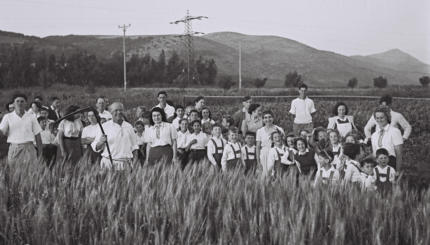The kabbalistic seder text known as Peri Eitz Hadar was originally popular in Sephardic (Spanish and Mediterranean) communities and unknown in the Ashkenazic (Eastern European) world. According to the author, this is due to the fact that in the Ashkenazic community, the eminent halakhic authority Jacob Emden (1697-1776) attributed Peri Eitz Hadar to Nathan of Gaza, a theologist who considered himself a prophet of Shabbetai Tzvi, the 17th-century pseudo-Messiah. Jewish authorities reviled Shabbetai Tzvi as a heretic because of his conversion to Islam. This material, therefore, was condemned by Emden as a heretical Sabbatean text.
While Emden was eager to discover Sabbatean influences in many works, modern scholarship does support his contention regarding Hemdat Yamim, the Sabbatean anthology that contains Peri Eitz Hadar. Nevertheless, this seder is a pure kabbalistic text of the Lurianic school, despite its inclusion in the controversial anthology Hemdat Yamim.
The author goes on to state that in modern times, with the mutual influence of Ashkenazic and Sephardic communities–especially in Israel–many kabbalistic works, including Peri Eitz Hadar, have increased in popularity in Ashkenazic communities as well.
This article is excerpted from a longer, footnoted work, and is the first of a three-part article. It is reprinted with permission of the author from Trees, Earth, and Torah: A Tu B’Shvat Anthology, edited by Ari Elon, Naomi Mara Hyman, and Arthur Waskow (Jewish Publication Society).
With your help, My Jewish Learning can provide endless opportunities for learning, connection and discovery.
The notion of a Tu Bishvat seder, that is, a ritual involving the eating of specific fruit, drinking wine, and studying or reciting specific selections from the sacred literature of Judaism, does not seem to have been known before the late 17th century. Until the 16th century, most kabbalists [mystics] were more concerned with providing mystical bases that would strengthen the motivation for observing the laws and traditions of classical Judaism than with creating new rituals. At that point, the kabbalists of Tzfat [the city of Safed] did create some new rituals, most notably the Kabbalat Shabbat service.
The kabbalistic Tu Bishvat seder seems to have been created sometime later, in the wake of kabbalistic creativity in 16th-century Tzfat.
Peri Eitz Hadar: A Book for Insiders
The text of the seder, which has come to be known as Peri Eitz Hadar, is essentially the same as the section on Tu Bishvat which appears in the Sabbatean-influenced anthology of kabbalistic customs, Hemdat Yamim (Izmir, 1731-1732).…
Formally, Peri Eitz Hadar contains four basic sections. After an introduction that explains the basis for the Tu Bishvat seder, there is a prayer to be said before the actual seder begins. This is followed by a description of the order of the fruit to be eaten and the way wine should be blended in each of the four cups. However, the bulk of the seder consists of selections from the Bible, early rabbinic texts, and the Zoharic [kabbalistic] literature. In fact, the greatest portion of this material is taken from the Zohar [a mystical commentary on the Torah that is the major text of Jewish mysticism].
As a result, the Peri Eitz Hadar is essentially a kabbalistic work, meant to be read and applied by a reader thoroughly schooled in the outlook of the kabbalah, particularly as it developed in the school of Isaac Luria. This fact renders the text, even in translation, virtually incomprehensible for a modem reader. This is due to several factors. First, the text does not explain the rather complex basic principles of kabbalah as they developed since the late 12th century. In particular, the text assumes that its reader is familiar and comfortable with the kabbalistic classic, Sefer ha-Zohar, an esoteric work characterized by obscure allusions and highly symbolic language.
In addition, the author’s outlook involves certain fundamental notions about nature, the cosmos, and the spiritual role that human beings are meant to play, which may be unfamiliar and even strange to a contemporary reader. Such notions, moreover, are not defended or justified, but are implicit in the author’s and the intended reader’s worldview.
The Kabbalistic View of Nature
The Tu Bishvat seder celebrates an important moment in the yearly cycle of nature, the appearance of fruit on trees. In the Land of Israel, this stage occurs during mid-winter. In order to understand how the Peri Eitz Hadar approaches this celebration, it is necessary to gain some understanding of how the kabbalists viewed nature. In general, the kabbalistic view shared many traits that were typical of other pre-modern cosmological systems, which tended to regard nature as in some sense sacred.
This approach to nature is in marked contrast to those that have become typical of the modern period. For the kabbalist, nature is neither a source to be exploited for utilitarian benefits nor a sentimental vestige of the past to be romanticized by poets and naturalists. It is rather an ultimate link in a chain of divine manifestation that directly emerges from the divine source of life.
Implicit here is a notion of sacred cosmology, which is not limited to material existence. The kabbalists’ faith involves a hierarchy of worlds that are ontologically higher than the material world. These worlds are populated by angels and spiritual forces that span the ontological regions that separate humanity and the material world from God. Moreover, the forces in these worlds serve as conduits and Sources for the divine energy that becomes manifest in nature and in Creation in general.
Although each world is characterized by an increasing degree of opacity that veils its divine root, all worlds share a common underlying structure. Thus contemplation of any world can lead to knowledge of the structure of the ultimate theosophical realm. This realm is the world of the ten sefirot [emanations], which is composed of the ten divine qualities and aspects that constitute the inner life of God, insofar as it is accessible to human imagining. This principle is no less true of nature. Indeed, nature (along with the human body) is, in a sense, the most available arena of divine revelation, since the higher worlds are not apparent to the senses. As such, nature may serve as a mirror in which all of the mysteries of the concealed Godhead are reflected.
Nature is Like Torah
This fundamentally sacred view of nature renders it comparable to the Torah itself. For the kabbalist, the Torah is not merely an account of the sacred history of Israel and its divinely mandated laws. It is a primary manifestation of divine revelation. All of the secrets and mysteries of the cosmos and the inner workings of the Godhead are somehow contained within it. However, it is a cipher, which only yields its concealed meanings to those who hold the keys of divine gnosis, the kabbalists, who through contemplation and mystical experience have gained access to the symbol system that opens the Torah’s deeper levels of meaning.
For the kabbalist, nature parallels the Torah. The very same secrets that are concealed within the quintessential sacred text may be learned through directly contemplating aspects of nature. The structure of different kinds of fruit, the growing patterns of trees, the habits of birds, indeed all natural phenomena are, in essence, aspects of a divine epiphany that proclaims the truth of God’s existence.
However, here it should be added that the kabbalist’s position is not identical to that of medieval religious philosophers, like Maimonides, who also viewed nature as a source for knowledge of God. In their view, the knowledge of the wondrous construction of nature and its laws led to an appreciation for its Creator. Here, knowledge of God is theosophical. It regards nature as a symbolic representation of the hidden divine realm and not merely as an immaculately designed product of divine engineering.
seder
Pronounced: SAY-der, Origin: Hebrew, literally "order"; usually used to describe the ceremonial meal and telling of the Passover story on the first two nights of Passover. (In Israel, Jews have a seder only on the first night of Passover.)
Sephardic
Pronounced: seh-FAR-dik, Origin: Hebrew, describing Jews descending from the Jews of Spain.
Shabbat
Pronounced: shuh-BAHT or shah-BAHT, Origin: Hebrew, the Sabbath, from sundown Friday to sundown Saturday.
Torah
Pronunced: TORE-uh, Origin: Hebrew, the Five Books of Moses.
Tu Bishvat
Pronounced: too bish-VAHT (oo as in boot), Origin: Hebrew, literally "the 15th of Shevat," the Jewish month that usually falls in January or February, this is a holiday celebrating the "new year of the trees."
Zohar
Pronounced: ZOE-har, Origin: Aramaic, a Torah commentary and foundational text of Jewish mysticism.



